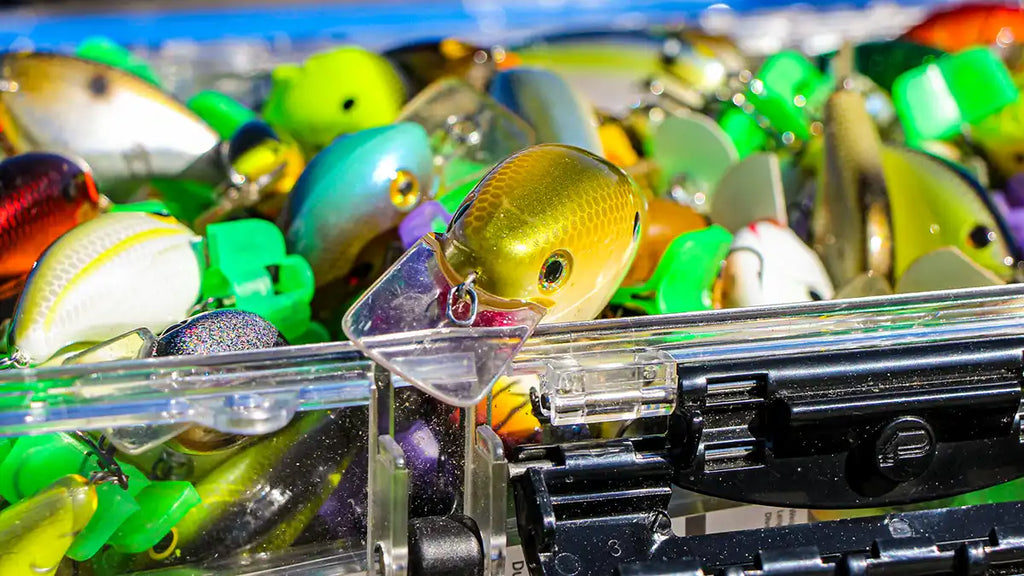

A curated list of the 10 most effective and versatile bass fishing lures, from soft plastics to hard baits, with pro tips on how to use them. Walking into a tackle shop can be intimidating. You see a wall filled with thousands of lures in every shape, size, and color imaginable. For many anglers, especially beginners, the key question is, what lures to use for bass? Choosing the right lure can feel like a lottery. This guide is your shortcut to success. We've compiled a list of the 10 most essential and versatile that will catch fish in almost any condition. Master these, and you'll build the confidence to tackle any body of water.

1. The Soft Plastic Stick Bait (The "Do-Nothing" Wonder)
The soft plastic stick bait is arguably the most versatile bass lure ever created. Its simple, cigar-like shape doesn't look like much, but its magic is in its subtlety.

Why It Works
This lure has a slow, tantalizing shimmy as it falls through the water. This subtle action perfectly imitates a dying baitfish. Bass, being opportunistic predators, cannot resist such an easy meal. Its versatility allows it to be rigged in multiple ways, making it effective in various situations.
How to Fish It
The most popular technique is the wacky rig, where you hook the worm through the middle. Cast it out, let it sink on a slack line, and watch for the tell-tale jump in your line. You can also use a Texas rig to make it weedless for fishing in heavy cover. This is a must-have in your collection.
2. The Squarebill Crankbait (The Shallow Water Bruiser)
When you need to cover water in shallow areas, the squarebill crankbait is your go-to lure. Its square-shaped lip is designed to deflect off cover like rocks and wood.

Why It Works
The erratic, darting action created when the squarebill deflects off cover triggers aggressive reaction strikes from bass. Instead of getting snagged, it bounces off obstacles, often drawing an immediate bite from a nearby fish that was startled into attacking.
How to Fish It
The key is to cast it past your target and retrieve it so it makes contact with the cover. Don't be afraid of "bumping" it into rocks and laydowns. Vary your retrieve speed. Sometimes a steady retrieve works best, while other times a stop-and-go cadence is more effective.
3. The Spinnerbait (The All-Terrain Search Tool)
A spinnerbait is a fantastic tool for finding active fish. Its unique design allows it to come through weeds and wood with surprising ease, making it a great "search bait."

Why It Works
The combination of the spinning blades creates flash and vibration. This mimics a school of baitfish and appeals to a bass's lateral line, its system for detecting movement and vibrations. It's a lure that calls fish in from a distance.
How to Fish It
The most common technique is a simple, steady retrieve, known as "slow rolling." You can also "yo-yo" it by lifting your rod tip and letting it fall. This change in speed and depth can trigger strikes from following fish. It's a key part of any complete box.
4. The Jig (The Old Faithful Bottom Bouncer)
If there's one lure known for catching big bass, it's the jig. A jig consists of a lead head with a hook and a silicone or rubber skirt. It's often paired with a soft plastic trailer.
Why It Works
A jig perfectly imitates one of a big bass's favorite meals: a crawfish. Its design allows it to be fished effectively on the bottom, where big bass often feed. The jig's big fish appeal is legendary among seasoned anglers.
How to Fish It
Techniques like flipping and pitching allow you to place a jig precisely into heavy cover. You can also drag it slowly along the bottom to mimic a scurrying crawfish. The bite is often a subtle "tick" or a mushy feeling, so stay focused!
5. The Topwater Popper (The Heart-Stopper)
There is nothing more exciting in fishing than a topwater explosion. The popper is a classic topwater lure designed to create a surface disturbance that drives bass crazy.
Why It Works
The cupped face of a popper creates a "blooping" or "popping" sound when you twitch your rod. This sound imitates a struggling baitfish or a feeding bluegill on the surface. It triggers a bass's predatory instinct to attack from below.
How to Fish It
The key is a "pop and pause" retrieve. Give the rod a short, sharp twitch to make the lure pop, then let it sit still for a few seconds. Most strikes happen during the pause. Using effective is a thrilling way to fish.
6. The Multi-Jointed Swimbait (The Realistic Deceiver)
For clear water or when targeting big, wary bass, a realistic swimbait can be the difference-maker. Multi-jointed swimbaits offer an incredibly lifelike swimming motion.
Why It Works
The segments of the lure allow it to move with a natural, S-shaped swimming action. This lifelike motion can fool even the smartest bass into thinking it's a real fish. For a great example, check out the realistic action of the .
How to Fish It
A slow, steady retrieve is usually all you need. Let the lure's design do the work. You can occasionally add a twitch or a pause to break up the cadence and trigger a strike.
7. The Soft Plastic Creature/Craw Bait (The Ultimate Trailer)
Soft plastic baits that imitate crawfish or other creatures are essential. They can be fished alone or, more commonly, as a trailer on the back of a jig.
Why It Works
These baits mimic the natural forage that bass feed on daily. Adding a craw-style trailer to a jig adds bulk, action, and a more realistic profile. Our is a perfect example of a versatile soft bait that bass find irresistible.
How to Fish It
When used as a jig trailer, the claws or appendages will flutter as the jig falls or is dragged. You can also rig them Texas-style and fish them on their own through cover.
8. The Bladed Jig / Chatterbait (The Modern Powerhouse)
The bladed jig, often called a Chatterbait (a brand name), has become a dominant force in bass fishing. It combines the flash of a spinnerbait with the vibration of a crankbait.
Why It Works
The hexagonal blade at the front of the lure vibrates wildly on the retrieve. This creates an intense, erratic action and a thumping vibration that bass can't ignore. It's an aggressive lure for aggressive fish.
How to Fish It
A straight retrieve is highly effective, but don't be afraid to rip it out of grass or give it a sharp twitch to change its action. This lure is excellent for covering water and triggering reaction strikes.
9. The Jerkbait (The Cold Water Specialist)
When the water is cold in the spring or fall, bass can become sluggish. A suspending jerkbait is the perfect tool to entice these lethargic fish.
Why It Works
A jerkbait has an erratic, darting action when you twitch your rod. The key is its ability to suspend perfectly still in the water during a pause. This gives sluggish bass a long time to inspect the lure and decide to strike.
How to Fish It
The retrieve is a "twitch-twitch-pause" cadence. The length of the pause is critical. In very cold water, you might let it sit still for 10 seconds or more. Most bites will come during this pause.
10. The Hollow Body Frog (The Heavy Cover Champion)
For fishing over the thickest, nastiest vegetation like lily pads or matted grass, nothing beats a hollow body frog.
Why It Works
Its weedless design, with the hooks riding up against the body, allows it to slide over heavy cover without getting snagged. The commotion it makes on the surface draws bass up from below for explosive strikes.
How to Fish It
Cast the frog onto the cover and work it back with a combination of twitches and pauses, a technique called "walking the frog." Be prepared for a huge blow-up, and wait a second before setting the hook to ensure the fish has the lure.
Bonus: How to Choose the Right Lure Color
Choosing a color can be simple. Follow this basic rule of thumb.
For Clear Water: Natural Colors are Key
In clear water, bass rely heavily on sight. Choose colors that mimic local baitfish, like shades of green, brown, and silver.
For Stained/Murky Water: Go Bold and Bright
In dirty water, bass use their lateral line more. Choose colors that create a strong silhouette, like black and blue, or bright colors like chartreuse and white that are easier to see.
Build Your Arsenal and Catch More Bass
You don't need a thousand different lures to be a successful bass angler. This list of the top 10 best bass lures covers nearly every situation you'll encounter. By mastering these classics, you'll spend less time guessing and more time catching fish.
Ready to build your collection with proven winners? and start catching more fish today!
What's your #1 confidence lure for bass? Let us know your secret weapon in the comments!
Frequently Asked Questions (FAQ) about Bass Lures
If I could only buy one lure from this list, which should it be?
A soft plastic stick bait, like a Senko. Its incredible versatility allows you to fish it in many different ways (wacky rig, Texas rig, weightless). It catches fish in both clear and dirty water, and it's effective year-round.
What are the best lure colors to start with?
Start with a few basic, versatile colors. For clear water, get something natural like Green Pumpkin. For dirty water, get something dark like Black/Blue. And for an all-purpose bright color, have something in White or Chartreuse.
Do I need expensive lures to catch bass?
Absolutely not. While some high-end lures have premium components, the design and action are what matter most. Many affordable lures, like the ones you can find when you , catch just as many, if not more, fish. It's more about presentation than price.
How do I know when to switch lures?











